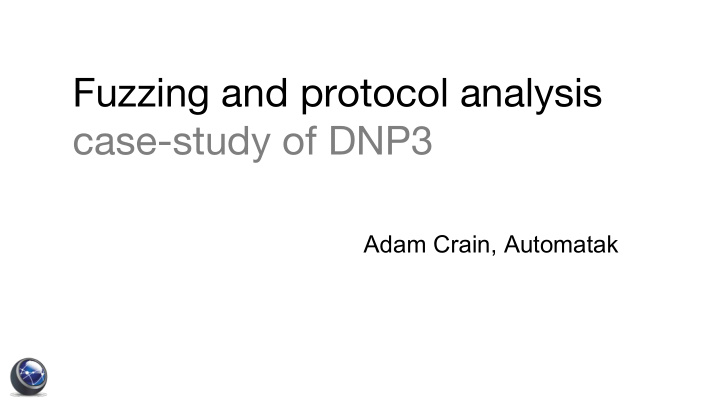



Fuzzing and protocol analysis case-study of DNP3 Adam Crain, Automatak
Developed by Harris Corp, handed over to a vendor-neutral User Group in 1993. Many features have been “bolted on”, including security.
Layered Architecture IED/RTU or your SCADA master User code Application Service Data Unit (ASDU) Typical max size of 2KB Application Layer semantics == functions + objects Tx segmentation Transport Layer Rx re-assembly of APDUs Adds CRCs and addressing. Error Link Layer checking and (de) multiplexing.
Application layer messages
Application-layer semantics OBJECTS Measurements, time sync, file transfer, controls, etc, etc FUNCTION CODES ● ∞ combinations READ WRITE ● multiple types per message OPERATE ● Some function codes are CONFIRM “function only” … .. RESPONSE UNSOLICITED
Project Robus • Started in April 2013 • 30+ CVEs found via fuzzing • Deep study of failure modes in one protocol • automatak.com/robus
Focus on serial / masters
DNP3 Fuzzing x Num Test Cases Test DNP3 Message (DL, TL, or AL) x Num Retry (10) Request Link States Request Response Link Status
Common Faults F0 82 00 00 01 00 02 00 00 00 00 FF FF FF FF 0 4294967295 Group 1 4 byte Unsolicited Variation 0 start/stop Response Sizeless?! uint32_t count = stop - start + 1; // ← integer overflow
Less Common Faults Unexpected function code / object combinations DD 82 00 00 0C 01 00 00 01 rnd(11) rnd(11) CROB #1 CROB #2 Control 1 byte Unsolicited Relay start/stop ● buffer overrun Response Output Block ● not malformed! ● unexpected objects ● accepts broadcast
DNP3 Security ● Tightly coupled to the DNP3 Application Layer application layer Secure Authentication ● Auth-only ● New functions Transport Layer ● New objects ● 2 modes of authentication Link Layer
Porous Trust Boundary • Data is dangerous, Application Layer intended function matters not. Logging %n%n%n • Every time you extend DNP3, you make it less Complex Parsing secure. • Optional challenges make security state machine overly complex
2 modes of authentication “Aggressive mode” – Challenge-response – 2 1 pass authentication pass authentication
Aggressive mode message
Issue #1: Aggressive-mode ambiguity Header / Function ///// Payload Headers //// ???? You can only tell if this is an aggressive mode request by speculatively parsing the 1 st object header. Ambiguity is dangerous.
Issue #2: Lack of an envelope for HMAC Header / Function USER, CSQ //////////////////////////////////////////// HMAC DNP3 headers cannot be “skipped”. They must be parsed sequentially (at least lightly), so that you known where the next one starts.
“Session key status object” • Total size framed by TLV in wrapping header • Composed of fixed-size and variable-length subfields • Final v-length field is the remainder of the encapsulation.
“Update key change reply” • Total size framed by TLV in wrapping header • Composed of fixed-size and variable-length subfields • Final v-length field is the remainder of the encapsulation AND a length prefix.
What does the spec have to say?
SA Conclusions • Prefer a layered approach to SCADA security to that decouples legacy protocol encodings/semantics from security. • Design security to address both function and implementation attack surface.
How can langsec help? Critical infrastructure vendors need better tools • besides hand-rolled parsers. Standards bodies need the theory/guidance to • produce better designs. Protocols need reference implementations to guide • their evolution.
Questions?
Recommend
More recommend